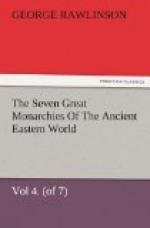[Illustration: Plate XI.]
For the size and plan of the city we are thus of necessity thrown back upon the reports of ancient authors. It is not pretended that such reports are in this, or in any other case, deserving of implicit credence. The ancient historians, even the more trustworthy of them, are in the habit of exaggerating in their numbers; and on such subjects as measurements they were apt to take on trust the declarations of their native guides, who would be sure to make over-statements. Still in this instance we have so many distinct authorities—eyewitnesses of the facts—and some of them belonging to times when scientific accuracy had begun to be appreciated, that we must be very in credulous if we do not accept their witness, so far as it is consentient, and not intrinsically very improbable.
According to Herodotus, an eye-witness, and the earliest authority on the subject the enceinte of Babylon was a square, 120 stades (about 14 miles) each way—the entire circuit of the wall being thus 56 miles, and the area enclosed within them falling little short of 200 square miles. Ctesias, also an eyewitness, and the next writer on the subject, reduced the circuit of the walls to 360 stades, or 41 miles, and made the area consequently little more than 100 square miles. These two estimates are respectively the greatest and the least that have come down to us. The historians of Alexander, while conforming nearly to the statements of Ctesias, a little enlarge his dimensions, making the circuit 365, 368, or 385 stades. The differences here are inconsiderable; and it seems to be established, on a weight of testimony which we rarely possess in such a matter, that the walls of this great town were about forty miles in circumference, and enclosed an area as large as that of the Landgraviat of Hesse-Homburg.
It is difficult to suppose that the real city—the streets and squares—can at any time have occupied one half of this enormous area, A clear space, we are told, was left for a considerable distance inside the wall—like the pomaerium of the Romans—upon which no houses were allowed to be built. When houses began, they were far from being continuous; gardens, orchards, even fields, were interspersed among the buildings; and it was supposed that the inhabitants, when besieged, could grow sufficient corn for their own consumption within the walls. Still the whole area was laid out with straight streets, or perhaps one should say with roads (for the houses cannot have been continuous along them), which cut one another everywhere at right angles, like the streets of some German towns. The wall of the town was pierced with a hundred gates, twenty-five (we may suppose) in each face, and the roads led straight to these portals, the whole area being thus cut up into square blocks. The houses were in general lofty, being three or even four stories high. They are said to have had vaulted roofs,




